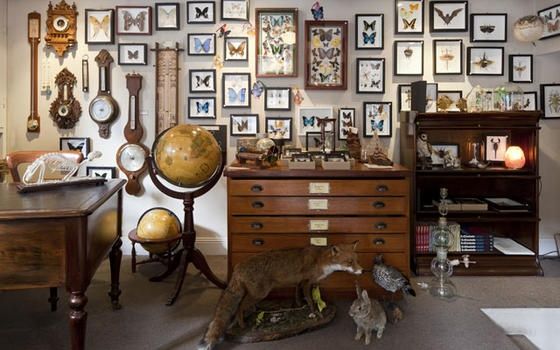Victorian Naturalist Room Decorating Ideas: Steampunk Style
Victorian naturalist decorating is based on the 18th-century obsession with observing, cataloguing and categorising nature. Steampunk adds retro-futuristic elements.
Like any category of steampunk, Victorian naturalism has almost endless subcategories depending on the levels of technology, fantasy and personal story the steampunk prefers. Victorian Naturalism is considered separate to Victorian Mad Scientist, but considerable overlap can occur.
Table of Contents

A Goth Inspired Victorian Naturalist Room
The taxidermy and skulls of Victorian naturalism lend themselves to a Gothic, “Memento Mori”-themed room. Add dark red velvet draperies, display a stuffed pheasant under a glass dome on a small table, and generally amp up the macabre nature of having animal body parts lying around the house.
Startlingly large insects under glass are appropriate for this kind of room. For an even more disturbing steampunk twist, purchase one of Lisa Black’s specimens of steampunk taxidermy.
A Soft Victorian Naturalist Room
For a more calm, feminine room consider what accoutrements a Victorian lady birdwatcher might have.
Observational drawings of birds and flowers rendered in watercolour might adorn a wooden easel; a pair of binoculars might lie on the petticoat table with a white glove; birds’ eggs might be neatly arranged in a cut-glass dish.
Draw inspiration from the softer side of nature – think roses, nature journals, Beatrix Potter, butterflies, butterfly nets and a collection of feathers.
An Explorer’s Victorian Naturalist Room
The 2009 Pixar film Up featured, on Charles F Muntz’s dirigible, an impressive example of what a Victorian naturalist’s house might look like after visiting foreign climes. The airship had a museum-like, formal feel to it with skeletons of strange beasts everywhere, mounted on plinths and suspended from the ceiling.
This kind of look is a little difficult to pull off in a private home; however, a keen steampunk may be able to find some unique pieces such as a stuffed alligator and combine them with a Victorian explorer theme.
Old maps of darkest Africa, tribal masks and art, pieces of ivory, pith helmets and goggles can give the illusion of a scientist-cum-explorer who is cataloguing his finds. Add a couple of spears, a magnifying glass, King Solomon’s Mines and bottles of quinine for accessories.
Other Victorian Naturalist Room Decorating Ideas
- Consider choosing a field other than biology for the room’s focus. A geologist’s room could be decorated with labelled chunks of quartz and other rocks, with perhaps a hint of alchemy, fossils and mysterious jewels. A Victorian astronomer’s room could make the most of the quintessentially steampunk telescope, as well as star charts and the signs of the Zodiac. A marine biologist room could take its cue from 2000 Leagues Under the Sea, featuring marine steampunk gear such as diving bells as well as fish skeletons and an impressive tropical tank.
- One piece of furniture worth investing in is a wunderkabinet. These tallboys or wardrobes filled with small drawers embody the Victorian need to categorise, collect and contain. They also appeal to the steampunk visual aesthetic of solid, natural materials. A wunderkabinet can display treasures in shelves and half-open drawers, and imply more concealed goodies within – handy for steampunks who have not yet built up a sizeable collection! Better still, the drawers can hide away items that don’t match the room’s décor, such as board games and craft supplies. Wunderkabinets tend to be expensive, but can really pull a room together and act as a focal point.
- Even a small display of mounted butterflies or labelled feathers looks impressive when mounted in a wide dark wooden frame. A few of these displays can be spaced across a wall for a clean, uncluttered look, or jumbled close together on a small wall in authentic Victorian chaos.
- Animal skins as floor coverings can quickly up the “naturalism” of a room. Ivory, skeletons, insects and stuffed animals are also components of the Victorian naturalist look. However, all these items must be purchased with caution. Some, particularly more exotic items, may have been obtained through poaching or illegal trade. Second-hand taxidermy specimens should also be inspected for moths or other signs of poor taxidermy. It’s also worth bearing in mind that these kinds of objects may make guests and small children nervous!

















